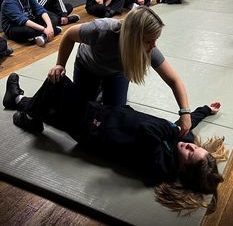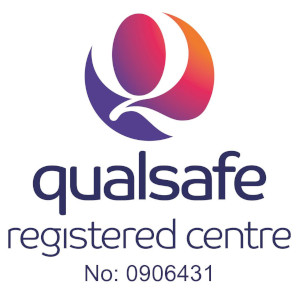The recovery position is one of the simplest yet most powerful first aid techniques you can learn. If someone becomes unconscious but is still breathing, their body loses the ability to protect the airway. This means their tongue can fall back and block it, or fluids such as saliva, vomit, or blood could cause choking. This is why the recovery position is important.
By placing someone in the recovery position, you are using gravity to your advantage. The airway is kept open, the head is tilted back slightly to allow easy breathing, and fluids can drain safely out of the mouth instead of into the lungs. This reduces the risk of suffocation and keeps oxygen flowing to the brain until help arrives.
Every second counts in an emergency. Taking quick action and placing someone in the recovery position can quite literally be the difference between life and death. It’s a skill that anyone, not just trained first aiders, should know, because accidents and medical emergencies can happen anywhere, at any time.
Why the Recovery Position is Important
Emergencies don’t just happen in hospitals or workplaces, they can happen anywhere. Someone might faint at the supermarket, collapse after drinking too much on a night out, or lose consciousness from a head injury at home. In all of these everyday situations, the person may still be breathing but unable to protect their own airway.
supermarket, collapse after drinking too much on a night out, or lose consciousness from a head injury at home. In all of these everyday situations, the person may still be breathing but unable to protect their own airway.
That’s where the recovery position comes in. By rolling an unconscious but breathing casualty onto their side, you keep their airway clear and greatly reduce the risk of choking on their tongue, vomit, or saliva. This simple action ensures oxygen continues to flow, preventing potentially life-threatening complications while waiting for emergency help to arrive.
The recovery position isn’t complicated, and you don’t need medical training to do it, but it can make the difference between life and death in those crucial moments.
What is the Recovery Position?
The recovery position is a safe and stable way of laying someone on their side when they are unconscious but still breathing. It’s designed to protect the most important thing in that moment, their airway.
When a person becomes unconscious, their muscles relax, including those in the throat and mouth. This means the tongue can fall back and block the airway, or fluids like saliva, vomit, or even blood can collect and cause choking. If this happens, breathing becomes difficult or may stop altogether.
By placing someone in the recovery position, you are using gravity to keep their airway clear. Their head is tilted slightly back so they can breathe more easily, and their mouth is angled downward so anything in it can drain out rather than blocking the throat.
It’s a simple step, but it makes a huge difference. Instead of lying flat on their back, where the risks are high, the person is placed in a safe, supported position that keeps them stable until professional medical help arrives.
How to Put Someone in the Recovery Position – Step by Step
If a person is unconscious but breathing, follow these steps:
-
Check for danger – make sure the area is safe for both you and the casualty.
-
Kneel beside them – lie them flat on their back and kneel next to their chest.
-
Position the nearest arm – place the arm closest to you at a right angle to their body, with the elbow bent and the palm facing up.
-
Move the far arm – bring the arm furthest away across their chest and place the back of their hand against their cheek (the one nearest to you). Hold it there.
-
Bend the far knee – lift the leg furthest away from you and bend the knee so the foot is flat on the floor.
-
Roll them towards you – while holding their hand against their cheek, gently pull on the bent knee to roll them onto their side.
-
Open the airway – tilt their head back slightly to keep the airway open.
-
Keep monitoring – check they are still breathing normally and stay with them until help arrives.
💡 Tip: If you need to leave the person briefly to get help, make sure they are safely in the recovery position before you go.
When Should You Use the Recovery Position?
The recovery position is not for every situation, it’s specifically used when someone is unconscious but still breathing normally. Here’s when to use it (and when not to):
✅ Use the recovery position if:
-
A person has collapsed, is unresponsive, but you can see their chest rising and falling normally.
-
They are breathing but unable to protect their own airway (for example, after fainting, a seizure, or drinking too much alcohol).
-
You need to keep them safe while waiting for emergency services.
❌ Do not use the recovery position if:
-
The person is not breathing – in this case, you must call 999/112 immediately and begin CPR.
-
You suspect a spinal injury – unless their airway is blocked and you cannot keep it clear any other way. Moving them could cause further harm, so only do so if absolutely necessary to save their life.
⚠️ Always remember: Even when someone is in the recovery position, you must continue to monitor their breathing and be ready to act if their condition changes.
Everyday Situations Where the Recovery Position May Be Needed
-
Fainting in a public place – someone becomes unresponsive after standing in a hot room or skipping a meal.
-
After a seizure – once the jerking movements stop and the person is unconscious but breathing.
-
Alcohol-related collapse – a person passes out after drinking too much on a night out.
-
Head injury – someone is knocked unconscious during sport or an accident but is still breathing.
-
Medical conditions – for example, a diabetic person who loses consciousness or someone with a sudden drop in blood pressure.
In all of these everyday situations, the recovery position helps keep the airway clear and buys valuable time until professional help arrives.
⚠️ Safety Reminder: What To Do If Someone Is Unconscious
If you ever find yourself in this situation, remember these key steps:
-
Call for help immediately – dial 999/112 and explain that the person is unconscious. Stay on the line and follow the operator’s instructions.
-
Check their breathing carefully – look for chest movement, listen for breath sounds, and feel for air on your cheek.
-
If they are breathing normally – place them in the recovery position and keep monitoring.
-
If they are not breathing – do not put them in the recovery position. Start CPR straight away.
-
Never leave them unattended – stay with the casualty until professional help arrives.
-
Keep reassessing – sometimes a person’s breathing can change suddenly, so be prepared to adjust your actions.
👉 The recovery position is a temporary lifesaving step, not a cure. It keeps the person stable, safe, and breathing until trained medical professionals can take over.
What we Train – Why The Recovery Position is Important
All of our courses are tailored for the group of learners in a fun and friendly way. We consider your start and end times to adapt to your staff schedule. We can add any specifics from your polices, systems of work or previous accidents and risk assessments amendments. On our courses we can add any extra modules or certain previous accidents or near misses. The first aid courses can be adapted to include an element of health and safety. You are really getting a lot for your money and time taking courses with HMB Training Services. Let’s teach you what you need to know before giving CPR.
Emergency First Aid at work;
The Emergency First Aid at Work course is a vital training designed to equip individuals with the necessary skills to handle emergency situations in the workplace. This course provides participants with the knowledge and confidence to effectively respond to injuries, illnesses, and accidents that may occur on-site. Covering topics such as assessing and managing incidents, CPR, choking, bleeding control, and more. The Emergency First Aid at Work course ensures that attendees are prepared to provide immediate and appropriate assistance until professional medical help arrives. This comprehensive training is essential for creating a safe and prepared work environment, where employees can confidently handle emergencies and potentially save lives.
First Aid at Work;
The First Aid at Work course is a comprehensive training course designed to provide individuals with the knowledge and skills necessary to effectively respond to a wide range of medical emergencies in the workplace. This course goes beyond basic first aid training and covers topics such as assessing and managing incidents, CPR and AED usage, treating various injuries and illnesses, dealing with trauma, and more. Participants will learn how to handle emergency situations calmly and efficiently, ensuring the well-being of their colleagues and reducing the risk of further harm. The First Aid at Work course is essential for designated workplace first aiders, supervisors, and anyone responsible for the health and safety of employees. By completing this course, individuals can play a crucial role in promoting a safe and prepared work environment, where prompt and effective first aid can make a significant difference in saving lives and minimising the impact of injuries or illnesses.
Why is it vital to know how to administer First Aid
- Reduce accidents and injuries in your workplace
- Quick reaction and speed in administrating first aid will help save lives
- Reduce the number of incidents by sufficient trained first aiders
- Become more confident and knowledgeable in treating someone
- Increases safety within the workplace; having first aid training promotes a sense of safety and well-being
- Reduce the cost to the employer; reduce staff absences and fines from HSE
- First aid Training is a form of team-building activity
If you are looking to learn more about why the recovery position is important or first aid training courses click here
Additionally, please do call us on 01543 453338 to see how we can help with delivering group training courses



